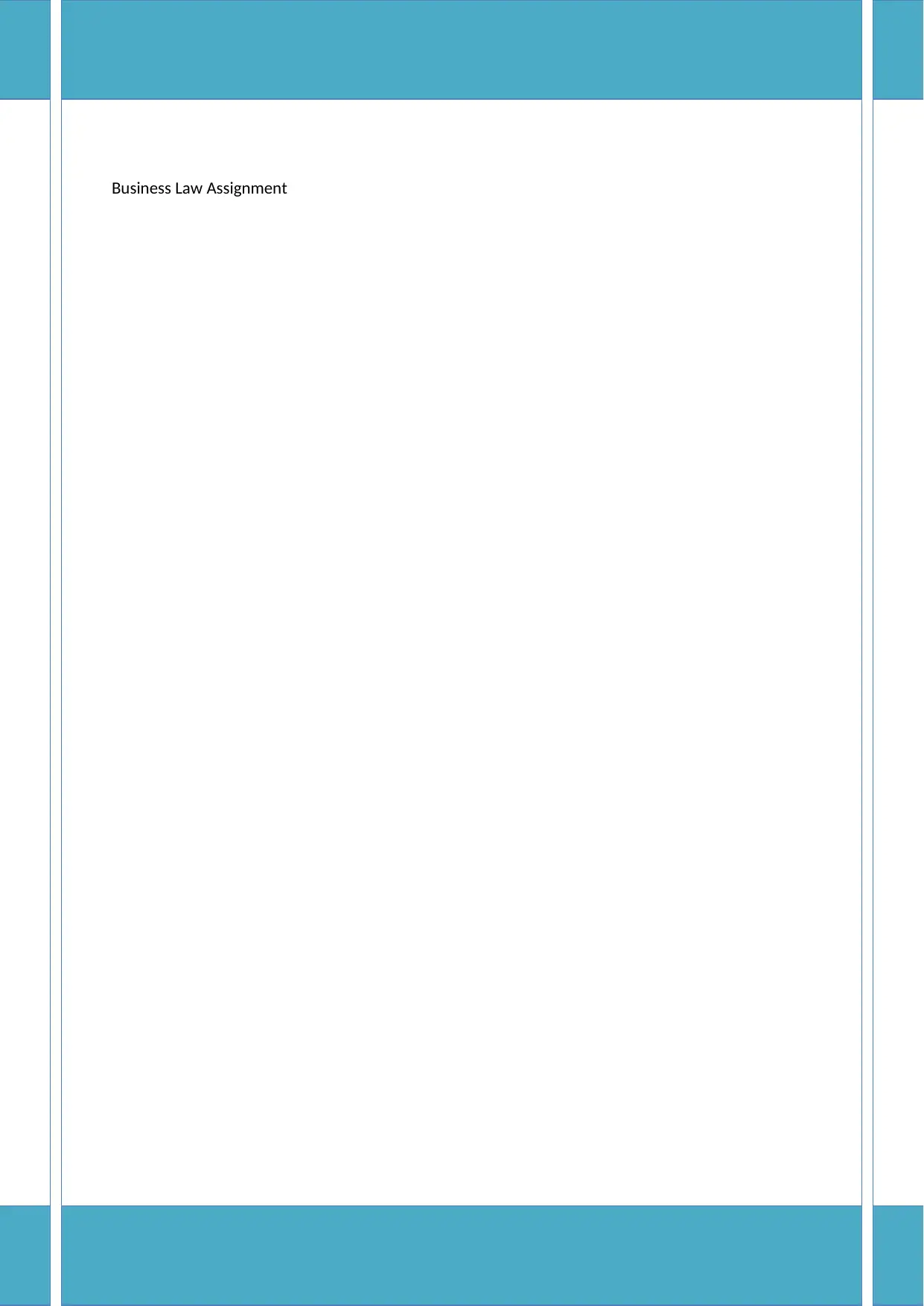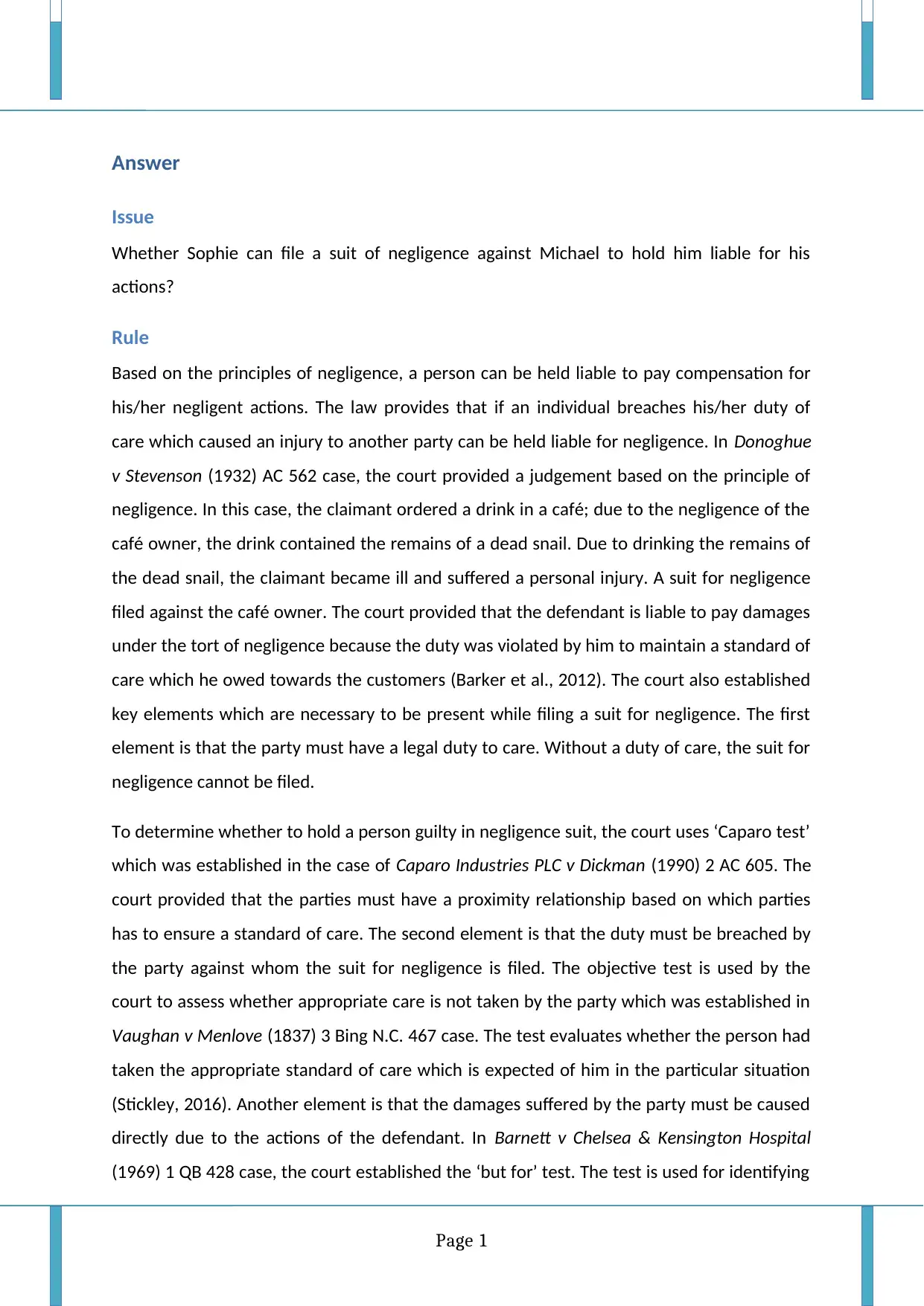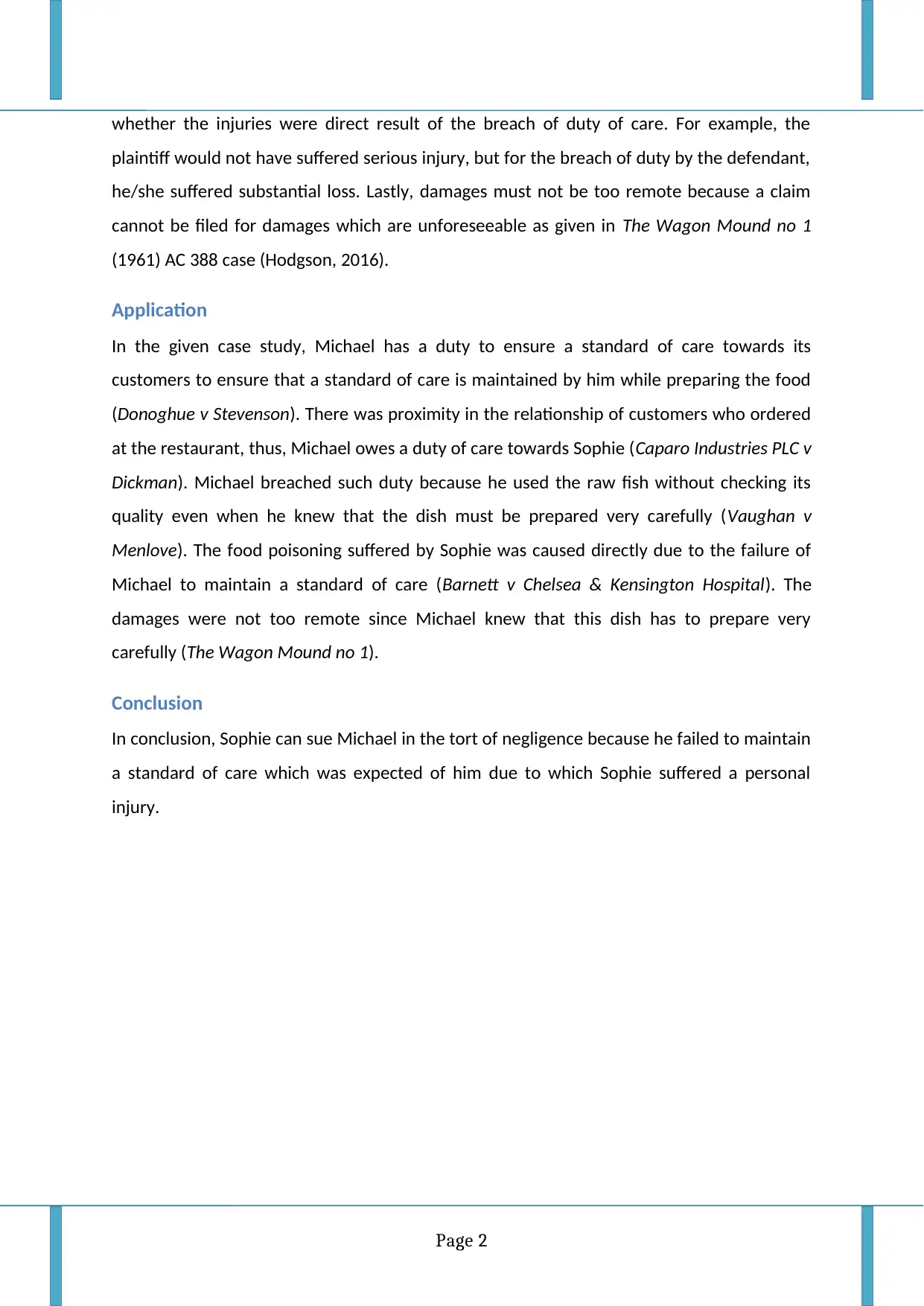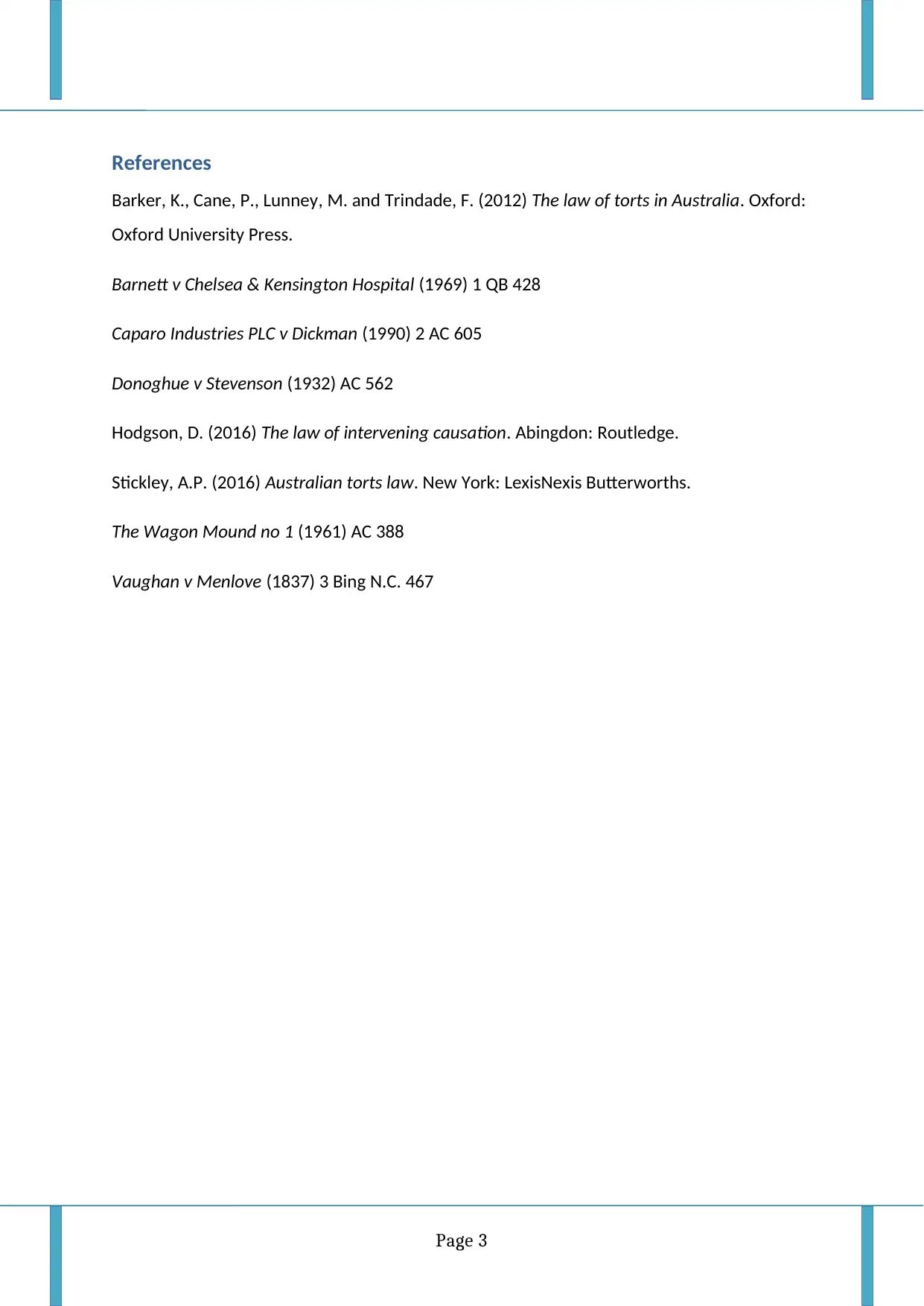Case Study: Sophie v. Michael - Negligence in Business Law (LAWS 1018)
VerifiedAdded on 2023/06/07
|4
|846
|119
Case Study
AI Summary
This case study provides a detailed analysis of a negligence claim between Sophie and Michael, based on the principles of business law. It examines whether Michael can be held liable for negligence due to food poisoning suffered by Sophie at his restaurant. The analysis applies the IRAC method (Issue, Rule, Application, Conclusion) and references relevant case laws such as Donoghue v Stevenson, Caparo Industries PLC v Dickman, Barnett v Chelsea & Kensington Hospital, and The Wagon Mound no 1. The study concludes that Sophie can sue Michael for negligence because he failed to maintain the expected standard of care, directly causing her injury. The document also includes a reference list and an assignment feedback document.

Business Law Assignment
Paraphrase This Document
Need a fresh take? Get an instant paraphrase of this document with our AI Paraphraser

Answer
Issue
Whether Sophie can file a suit of negligence against Michael to hold him liable for his
actions?
Rule
Based on the principles of negligence, a person can be held liable to pay compensation for
his/her negligent actions. The law provides that if an individual breaches his/her duty of
care which caused an injury to another party can be held liable for negligence. In Donoghue
v Stevenson (1932) AC 562 case, the court provided a judgement based on the principle of
negligence. In this case, the claimant ordered a drink in a café; due to the negligence of the
café owner, the drink contained the remains of a dead snail. Due to drinking the remains of
the dead snail, the claimant became ill and suffered a personal injury. A suit for negligence
filed against the café owner. The court provided that the defendant is liable to pay damages
under the tort of negligence because the duty was violated by him to maintain a standard of
care which he owed towards the customers (Barker et al., 2012). The court also established
key elements which are necessary to be present while filing a suit for negligence. The first
element is that the party must have a legal duty to care. Without a duty of care, the suit for
negligence cannot be filed.
To determine whether to hold a person guilty in negligence suit, the court uses ‘Caparo test’
which was established in the case of Caparo Industries PLC v Dickman (1990) 2 AC 605. The
court provided that the parties must have a proximity relationship based on which parties
has to ensure a standard of care. The second element is that the duty must be breached by
the party against whom the suit for negligence is filed. The objective test is used by the
court to assess whether appropriate care is not taken by the party which was established in
Vaughan v Menlove (1837) 3 Bing N.C. 467 case. The test evaluates whether the person had
taken the appropriate standard of care which is expected of him in the particular situation
(Stickley, 2016). Another element is that the damages suffered by the party must be caused
directly due to the actions of the defendant. In Barnett v Chelsea & Kensington Hospital
(1969) 1 QB 428 case, the court established the ‘but for’ test. The test is used for identifying
Page 1
Issue
Whether Sophie can file a suit of negligence against Michael to hold him liable for his
actions?
Rule
Based on the principles of negligence, a person can be held liable to pay compensation for
his/her negligent actions. The law provides that if an individual breaches his/her duty of
care which caused an injury to another party can be held liable for negligence. In Donoghue
v Stevenson (1932) AC 562 case, the court provided a judgement based on the principle of
negligence. In this case, the claimant ordered a drink in a café; due to the negligence of the
café owner, the drink contained the remains of a dead snail. Due to drinking the remains of
the dead snail, the claimant became ill and suffered a personal injury. A suit for negligence
filed against the café owner. The court provided that the defendant is liable to pay damages
under the tort of negligence because the duty was violated by him to maintain a standard of
care which he owed towards the customers (Barker et al., 2012). The court also established
key elements which are necessary to be present while filing a suit for negligence. The first
element is that the party must have a legal duty to care. Without a duty of care, the suit for
negligence cannot be filed.
To determine whether to hold a person guilty in negligence suit, the court uses ‘Caparo test’
which was established in the case of Caparo Industries PLC v Dickman (1990) 2 AC 605. The
court provided that the parties must have a proximity relationship based on which parties
has to ensure a standard of care. The second element is that the duty must be breached by
the party against whom the suit for negligence is filed. The objective test is used by the
court to assess whether appropriate care is not taken by the party which was established in
Vaughan v Menlove (1837) 3 Bing N.C. 467 case. The test evaluates whether the person had
taken the appropriate standard of care which is expected of him in the particular situation
(Stickley, 2016). Another element is that the damages suffered by the party must be caused
directly due to the actions of the defendant. In Barnett v Chelsea & Kensington Hospital
(1969) 1 QB 428 case, the court established the ‘but for’ test. The test is used for identifying
Page 1

whether the injuries were direct result of the breach of duty of care. For example, the
plaintiff would not have suffered serious injury, but for the breach of duty by the defendant,
he/she suffered substantial loss. Lastly, damages must not be too remote because a claim
cannot be filed for damages which are unforeseeable as given in The Wagon Mound no 1
(1961) AC 388 case (Hodgson, 2016).
Application
In the given case study, Michael has a duty to ensure a standard of care towards its
customers to ensure that a standard of care is maintained by him while preparing the food
(Donoghue v Stevenson). There was proximity in the relationship of customers who ordered
at the restaurant, thus, Michael owes a duty of care towards Sophie (Caparo Industries PLC v
Dickman). Michael breached such duty because he used the raw fish without checking its
quality even when he knew that the dish must be prepared very carefully (Vaughan v
Menlove). The food poisoning suffered by Sophie was caused directly due to the failure of
Michael to maintain a standard of care (Barnett v Chelsea & Kensington Hospital). The
damages were not too remote since Michael knew that this dish has to prepare very
carefully (The Wagon Mound no 1).
Conclusion
In conclusion, Sophie can sue Michael in the tort of negligence because he failed to maintain
a standard of care which was expected of him due to which Sophie suffered a personal
injury.
Page 2
plaintiff would not have suffered serious injury, but for the breach of duty by the defendant,
he/she suffered substantial loss. Lastly, damages must not be too remote because a claim
cannot be filed for damages which are unforeseeable as given in The Wagon Mound no 1
(1961) AC 388 case (Hodgson, 2016).
Application
In the given case study, Michael has a duty to ensure a standard of care towards its
customers to ensure that a standard of care is maintained by him while preparing the food
(Donoghue v Stevenson). There was proximity in the relationship of customers who ordered
at the restaurant, thus, Michael owes a duty of care towards Sophie (Caparo Industries PLC v
Dickman). Michael breached such duty because he used the raw fish without checking its
quality even when he knew that the dish must be prepared very carefully (Vaughan v
Menlove). The food poisoning suffered by Sophie was caused directly due to the failure of
Michael to maintain a standard of care (Barnett v Chelsea & Kensington Hospital). The
damages were not too remote since Michael knew that this dish has to prepare very
carefully (The Wagon Mound no 1).
Conclusion
In conclusion, Sophie can sue Michael in the tort of negligence because he failed to maintain
a standard of care which was expected of him due to which Sophie suffered a personal
injury.
Page 2
⊘ This is a preview!⊘
Do you want full access?
Subscribe today to unlock all pages.

Trusted by 1+ million students worldwide

References
Barker, K., Cane, P., Lunney, M. and Trindade, F. (2012) The law of torts in Australia. Oxford:
Oxford University Press.
Barnett v Chelsea & Kensington Hospital (1969) 1 QB 428
Caparo Industries PLC v Dickman (1990) 2 AC 605
Donoghue v Stevenson (1932) AC 562
Hodgson, D. (2016) The law of intervening causation. Abingdon: Routledge.
Stickley, A.P. (2016) Australian torts law. New York: LexisNexis Butterworths.
The Wagon Mound no 1 (1961) AC 388
Vaughan v Menlove (1837) 3 Bing N.C. 467
Page 3
Barker, K., Cane, P., Lunney, M. and Trindade, F. (2012) The law of torts in Australia. Oxford:
Oxford University Press.
Barnett v Chelsea & Kensington Hospital (1969) 1 QB 428
Caparo Industries PLC v Dickman (1990) 2 AC 605
Donoghue v Stevenson (1932) AC 562
Hodgson, D. (2016) The law of intervening causation. Abingdon: Routledge.
Stickley, A.P. (2016) Australian torts law. New York: LexisNexis Butterworths.
The Wagon Mound no 1 (1961) AC 388
Vaughan v Menlove (1837) 3 Bing N.C. 467
Page 3
1 out of 4
Related Documents
Your All-in-One AI-Powered Toolkit for Academic Success.
+13062052269
info@desklib.com
Available 24*7 on WhatsApp / Email
![[object Object]](/_next/static/media/star-bottom.7253800d.svg)
Unlock your academic potential
Copyright © 2020–2025 A2Z Services. All Rights Reserved. Developed and managed by ZUCOL.




